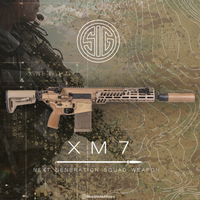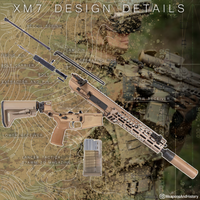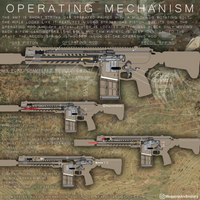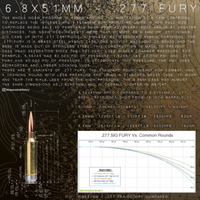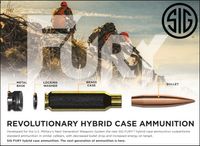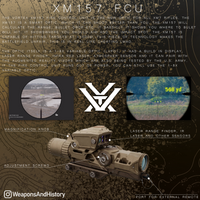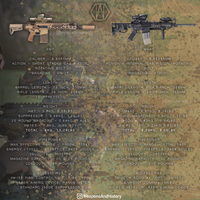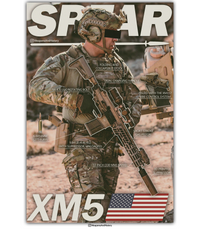XM7
The Sig sauer XM7 started out as the Sig MCX Spear, Sig Sauer's design for the Next Generation Squad Weapon program (NGSW) together with the XM250 general purpore machine gun. On April 19th 2022 the US army awarded a 10-year contract to SIG Sauer to produce the XM7 rifle, along with the XM250 automatic rifle, to replace the M4 and M249, respectively these model numbers are the next numbers sequentially to the weapons they are to replace. The first batch of 25 XM5s and 15 XM250s are planned to be delivered in late 2023. The Army plans to procure a total of 107,000 rifles and 13,000 automatic rifles for close combat forces including infantrymen, cavalry scouts, combat engineers, forward observers and combat medics. the xm7 was first known as the xm5, the name was changed due to colt holding the copyright name of the m5.
The XM7 is chambered in the new 6.8x51mm (or .277 fury), the new round is designed for penetrating near-peer adversary body armor. The 6.8x51mm is a hybrid case, featuring a brass case with a steel base to handle the high pressure.
The XM7 will be issued with suppressors. The suppressors are made with 3d printing like techniques and features ''no gas in the face for lefties''.
And also the vortex XM157 Fire Control Unit. The optic will calculate and adjust for bullet drop, windage, angle, etc. The optic has a number of sensors, including a compass, atmospherics, and a laser rangefinder to get the data it needs to make ballistic calculations and move the digital reticle automatically in fractions of a second to make it a true point-and-shoot system.
The XM7 is a scaled up version of the SIG MCX, and the MCX is based of the AR-15 and AR-18. It uses the very familiar 2 pin hinge upper and lower receiver design. The XM7 has a free float mlok handguard with quick detach sling points, fully ambidextrous controls, a folding and collapsible AR-15 stock, a AR like T-charging handle and a side handle, rumours about the charging handle is that it first only had a side charging handle and the T-charging was later added because soldiers were used to the T-charging handle. The top rail on the upper receiver is longer than usual, so you can put optics further on the rail and still have a proper zero.
The rifle is either fed from 20 or 25 round magazines (20 rounds being the standard one), the XM7 uses lancer tactical LT7AWM 20/25 SR-25 pattern magazines.
The XM-7 field stripped (this image is not accurate, it is drawn by me)
Like i said earlier, the XM7 has a 2 pin hinge system. The bolt carrier group is the same yet different on your standard AR. The bolt, extractor, ejector, firing pin is almost directly the same, but the bolt carrier is different.
The bolt carrier has no tail on the end like on a AR, because the recoil spring is not housed behind the bolt carrier. The recoil spring is now housed inside of the receiver, allowing the rifle to have a folding stock. The long rod above the bolt carrier may look like a long stroke gas piston like a AK, but its actually only a operating rod. The actual piston itself is housed inside of the gas block and only moves back slightly (a short stroke gas piston), the operating rod is there to transfer the momentum of the piston to the bolt carrier. The recoil spring too is housed inside of the operating rod, indeed like a AK. The XM7 bolt carrier has the same cuts on the right side as a AR for the forward assist, to manually lock the bolt into battery.
The gas piston is easily removable by first removing the gas plug in the front so you dont need to remove the entire handguard to clean the XM7 in the field.
The XM7 is like a mix between the AR-15 and AR-18. It is short stroke gas piston operated and it uses a multi-lug rotating bolt locking mechanism. Unlike the AR-15, it does not use Stoner's internal piston system but a short stroke gas piston and a operating rod fixed (but removable) to the bolt carrier
Step by step the firing mechanism of the XM7 explained
The chamber is loaded, the bolt is locked and the hammer is cocked and the rifle is one SAFE
1. The rifle is of SAFE, The trigger is pulled, allowing the hammer to fall forward and first strike the firing pin safety, and then the firing pin. The firing pin hits the primer of the loaded round,
2. The round is fired
3. The gas that propels the bullet is being tapped of by the gas port (a small hole in the barrel)
4. Gas enters the gasblock, it enters a chamber and it pushes against the piston, the piston moves backwards and the pistons pushes the operating rod backwards
5. The gas piston gave the operating rod and bolt carrier enough moment to move it backwards.
6. With the bolt carrier moving backwards, a cam track inside of the bolt carrier forces the cam pin to rotate, the cam pin is alligned with the bolt itself, so if the cam pin rotates, the bolt itself rotates.
7. When the bolt rotates, the locking lugs is no longer holding the barrel extensions and its allowed to move backwards. The opening of the bolt only happens when the pressure of the barrel is low enough
8. When the bolt carrier moves backwards, it resets the hammer to the cocked position, where the hook of the hammer hooks on the disconnector, the disconnector gets disconnected when you release the trigger and then the hammer rests on the trigger
9. The fired round gets ejected, the extractor pulls out the fired round and the ejector pushes against the bottom of the case, throwing out the spent round
10. When the bolt carrier reaches its end, the recoil spring pushes the bolt carrier back forwards
11. The magazine pushes a new round up, allowing the bolt to push a new round into the chamber
12. Cycle repeats, the round gets chambered, the bolt gets locked, the hammer falls and boom boom boom boom boom.
The whole NGSW program is based around the adaptation of a new cartridge to replace the intermediate 5.56x45mm for frontline units. a new full size cartridge being able to penetrate near-pear adversary body armor at greater distances. the ngsw requirements were that is must be 6.8mm or .277 inches.
sig came up with .277 cartridge. Ar rimless bottlenecked hybird cartrdige. The .277 Fury is a steel and brass case hybrid, The body of the case is made out of brass and the base is made out of steel, and in the middle is a aluminum washer holding the steel base and brass case together . this construction is made to prevent case head seperation since the .277 fury uses higher chamber pressure. for example, 5.56x45 has 62.000 psi of pressure, 7.62x51 has 60.000 psi, and .277 fury has 80.000 psi of pressure. to accomodate this pressure, the xm7 uses reinforced and longer locking lugs.
there are 2 variants of .277 fury, the standard round meant for combat, and a training round with less pressure and using a standard brass case. to wear and tear the rifle less from the high pressure. the 6.8mm case has almost the same dimensions as 7.62x51mm. and is overall lighter in weight.
the Vortex XM157 fire control unit is the new optic for all xm7 rifles. the XM157 is a smart optic, which it can shoot better than you. the XM157 will calculate the range, bullet drop etc. it bassicly it shows you where to bulet will hit. it showswhere you should aim and the impact spot. the XM157 is capable of hitting targets at +1000m. this piece of technology makes the battlefield unfair, this is in real life cheating lmao.
the optic itself is a 1-8x variable optic (lvpo), it has a build in display, laser range finder, infra red laser, atmospher sensor and it can pair with the augmented reality visors which are also being tested by the u.s. army.
if the fire control unit runs out of power, you can still use the 1-8x variable optic. Unfortunately, not alot of information is out on the XM157 FCU
The XM7 vs M4A1. The differences
The first thing people think about is ofcourse the weight, the XM7 25% heavier than the M4A1 and it uses 20 round magazines and the soldiers loadout is even less rounds.
is the xm7 right choice for the u.s. military?
benefits:
more powerfull, more range, way higher chance of hit probability and penetration of armor, standard issue suppressor, more accurate,
downsides:
rifle alone is 25% heavier, bulkier, more recoil and harder follow up shots, less reliable due to the external piston, less ammo capacity, less ammo per man.
is it the right choice?
my opinion, yes, but it can have improvements,
